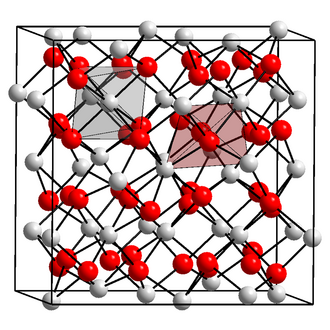Americium(III) oxide
Americium(III) oxide is a chemical compound composed of americium and oxygen with the formula Am2O3. It is one of the primary forms in which americium is used in the field of nuclear science and technology. Americium, a synthetic element, is part of the actinide series in the periodic table, and it exhibits multiple oxidation states, with +3 being the most stable and common. Americium(III) oxide plays a crucial role in various applications, including its use in nuclear batteries, neutron sources, and in certain types of nuclear reactors.
Properties
Americium(III) oxide is a solid compound that is characterized by its insolubility in water and most organic solvents, making it stable and suitable for various nuclear applications. It has a cubic crystal structure similar to that of lanthanum(III) oxide. The compound is highly radioactive and requires special handling and safety procedures to protect against its alpha radiation.
Synthesis
The synthesis of Americium(III) oxide typically involves the reduction of americium(IV) oxide (AmO2) or the direct oxidation of americium metal in the presence of oxygen. The controlled environment, including temperature and atmosphere, is crucial for ensuring the formation of Am2O3 without generating other unwanted americium oxides.
Applications
Americium(III) oxide is primarily used in the creation of smoke detectors, specifically in the ionization type smoke detectors, where it acts as a source of alpha particles. These alpha particles ionize the air in the detection chamber, making the air conductive and allowing the detection of smoke particles. Additionally, its use in nuclear batteries, also known as radioisotope thermoelectric generators (RTGs), is under research. In RTGs, the heat generated by the radioactive decay of americium can be converted into electricity, offering a long-lasting power source for space probes, unmanned remote facilities, and other applications requiring a compact and reliable energy source.
Safety
Handling Americium(III) oxide requires stringent safety measures due to its radioactivity. Protective clothing, gloves, and face protection are mandatory to prevent inhalation or ingestion of radioactive particles. Facilities dealing with americium compounds must also have proper ventilation and radiation shielding to protect workers and the environment.
Disposal
The disposal of Americium(III) oxide and other americium-containing waste is a complex process that must adhere to regulatory guidelines for radioactive waste management. This typically involves containment, immobilization, and long-term storage in designated facilities to prevent environmental contamination and exposure to living organisms.
Transform your life with W8MD's budget GLP-1 injections from $125.
W8MD offers a medical weight loss program to lose weight in Philadelphia. Our physician-supervised medical weight loss provides:
- Most insurances accepted or discounted self-pay rates. We will obtain insurance prior authorizations if needed.
- Generic GLP1 weight loss injections from $125 for the starting dose.
- Also offer prescription weight loss medications including Phentermine, Qsymia, Diethylpropion, Contrave etc.
NYC weight loss doctor appointments
Start your NYC weight loss journey today at our NYC medical weight loss and Philadelphia medical weight loss clinics.
- Call 718-946-5500 to lose weight in NYC or for medical weight loss in Philadelphia 215-676-2334.
- Tags:NYC medical weight loss, Philadelphia lose weight Zepbound NYC, Budget GLP1 weight loss injections, Wegovy Philadelphia, Wegovy NYC, Philadelphia medical weight loss, Brookly weight loss and Wegovy NYC
|
WikiMD's Wellness Encyclopedia |
| Let Food Be Thy Medicine Medicine Thy Food - Hippocrates |
Medical Disclaimer: WikiMD is not a substitute for professional medical advice. The information on WikiMD is provided as an information resource only, may be incorrect, outdated or misleading, and is not to be used or relied on for any diagnostic or treatment purposes. Please consult your health care provider before making any healthcare decisions or for guidance about a specific medical condition. WikiMD expressly disclaims responsibility, and shall have no liability, for any damages, loss, injury, or liability whatsoever suffered as a result of your reliance on the information contained in this site. By visiting this site you agree to the foregoing terms and conditions, which may from time to time be changed or supplemented by WikiMD. If you do not agree to the foregoing terms and conditions, you should not enter or use this site. See full disclaimer.
Credits:Most images are courtesy of Wikimedia commons, and templates, categories Wikipedia, licensed under CC BY SA or similar.
Contributors: Prab R. Tumpati, MD

